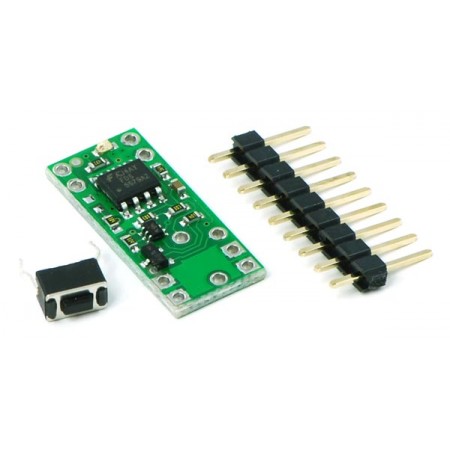Pololu Pushbutton Power Switch SV
Availability: Currently Unavailable
Note: The Pololu Pushbutton Power Switch is available in two voltage versions: standard voltage, 4.5-20 V and low voltage, 2.5-7.0 V. Please be sure to select the correct unit for your application.
Introduction
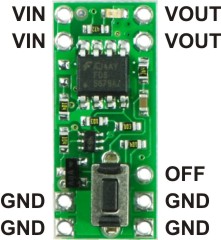 |
The Pololu Pushbutton Power Switch is a compact, solid-state power switch controlled by a momentary pushbutton switch. Because the switched current does not flow through the mechanical switch, a large variety of small, low-power switches can be used to control a substantial amount of power. The use of momentary pushbutton switches also allows multiple switches to be used in parallel to control the power to one load. The solid-state switch also allows the load to turn off its own power, which can be beneficial when used with battery chemistries sensitive to over-discharging. Please note that this switch has several drawbacks when compared to mechanical switches, so please be sure you fully understand this product before using it in your system.
Benefits and Limitations
The Pololu Pushbutton Power Switch works well in its intended application as a DC power switch for small robots, but because it is fundamentally different from a mechanical power switch, the benefits and drawbacks of the components must be fully considered.
Benefits over mechanical switches:
- Compact size
- Allows multiple (parallel) switches for improved user interface
- Better turn-on characteristics than a bouncing mechanical switch
- Limited LC spikes for low-resistance loads
- Allows self-shutoff
- Breadboard and perfboard compatible
Drawbacks compared to mechanical switches:
- Switch is one-directional (inherent body diode in MOSFET)
- Limited operating voltage range
- Switches DC only (does not maintain state through power disruptions or excessive noise)
- No complete isolation in off state
Specifications
- Dimensions: 0.4" x 0.9" x 0.125" (without header pins and pushbutton installed)
- Operating voltage: 4.5-20 V (SV version), 2.5-7.0 V (LV version)
- Maximum current: 10 A (see MOSFET datasheets)
- Weight without included pushbutton: 0.030 oz (0.85 g)
- Weight with included pushbutton: 0.035 oz (1.0 g)
- Draws very little current in off state (typically under 0.01 μA)
Typical Applications
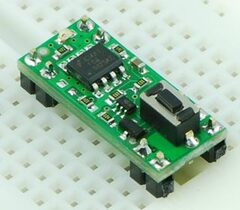 |
| Pololu Pushbutton Power Switch on a solderless breadboard. |
|---|
The Pololu Pushbutton Power Switch can fit in an 18-pin DIP (dual in-line package) footprint, making it compatible with solderless breadboards and perforated printed circuit boards with standard 0.1" spacing. For such applications, the included male header pins can be soldered to the switch PCB as shown in the picture to the right. Alternatively, wires can be soldered directly to the switch PCB for non-breadboard applications. For high-current applications, make sure that the wires can safely carry the current. Two pads/pins are provided for each of the power nodes, and multiple pads should be used for applications drawing over 5 A.
The included pushbutton switch can be used to trigger the switch. Alternatively, a separate pushbutton, such as a remote panel-mounted unit, can be used instead. Multiple pushbuttons can be wired in parallel for multiple control points, and each of the parallel pushbuttons will be able to turn the switch on or off. The latching circuit performs some button debouncing, but pushbuttons with excessive bouncing (several ms) might not function well with this product.
Principles of Operation
The Pololu Pushbutton Power Switch has two main components: a P-channel power MOSFET that switches the load current and a latching circuit that controls the gate of the MOSFET.
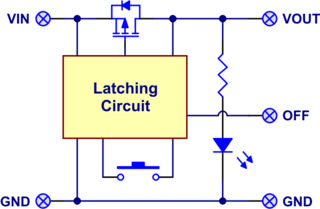 |
| Pololu Pushbutton Power Switch block diagram. |
|---|
The overall switch performance is determined by the MOSFET characteristics, which are specified in their datasheets. The standard voltage version uses the FDS6679AZ (421k pdf); the low-voltage version uses the FDS4465 (141k pdf). The latching circuit is designed to operate over a wide range of voltages and to draw very little current in the off state (typically under 0.01 μA). In the on state, the switch pulls the MOSFET gate to within 0.2 V of ground so that the MOSFET’s Vgs can be approximated as the supply voltage.
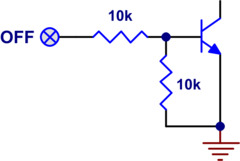 |
| Pololu Pushbutton Power Switch OFF input detail. |
|---|
The latching circuit controlling the power MOSFET includes an OFF input that can be used by the target device to shut off its own power. The internal structure of this input is shown to the right. Applying more than approximately 1 V to the OFF pin will cause the power switch to turn off. The maximum voltage for the OFF pin is 30 V independent of the switch voltage (VIN).
Characteristics at Limits of Operating Range
The switch operating range is limited by the ability to change state reliably. At low voltages, the switch is difficult to turn on, and the switch will turn itself off once the voltage falls far enough (typically 3 V and 1.5 V for the SV and LV versions, respectively). At high voltages, the switches become difficult to turn off. The reliability of turning off is affected by a combination of the supply voltage, the amount of bouncing on the pushbutton switch, and the amount of noise on the supply line. For applications at the high end of the operating range, tests should be performed to ensure that the device can properly turn off.
RobotSimple © 2025

 Robot and Robot Kit
Robot and Robot Kit Robot Controller
Robot Controller Servo Controller
Servo Controller Motor Controller and Driver
Motor Controller and Driver Computer Interface
Computer Interface Sensors
Sensors Arduino
Arduino Arduino Shield and Accessories
Arduino Shield and Accessories RC Interface
RC Interface Display
Display Prototyping
Prototyping Voltage Regulator
Voltage Regulator Miscellaneous
Miscellaneous Ball Casters
Ball Casters Switches
Switches Servo
Servo LEDs
LEDs Headers
Headers